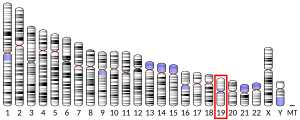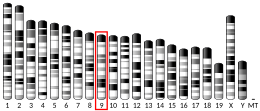DNM2
Dynamin-2 is a protein that in humans is encoded by the DNM2 gene.[5][6]
Function
[edit]Dynamins represent one of the subfamilies of GTP-binding proteins. These proteins share considerable sequence similarity over the N-terminal portion of the molecule, which contains the GTPase domain. Dynamins are associated with microtubules. They have been implicated in cell processes such as endocytosis and cell motility, and in alterations of the membrane that accompany certain activities such as bone resorption by osteoclasts. Dynamins bind many proteins that bind actin and other cytoskeletal proteins. Dynamins can also self-assemble, a process that stimulates GTPase activity. Four alternatively spliced transcripts encoding different proteins have been described. Additional alternatively spliced transcripts may exist, but their full-length nature has not been determined.[7]
Interactions
[edit]DNM2 has been shown to interact with:
Clinical relevance
[edit]Mutations in this gene have been associated to cases of acute lymphoblastic leukaemia,[10] or congenital myopathy (centronuclear type).[11]
References
[edit]- ^ a b c GRCh38: Ensembl release 89: ENSG00000079805 – Ensembl, May 2017
- ^ a b c GRCm38: Ensembl release 89: ENSMUSG00000033335 – Ensembl, May 2017
- ^ "Human PubMed Reference:". National Center for Biotechnology Information, U.S. National Library of Medicine.
- ^ "Mouse PubMed Reference:". National Center for Biotechnology Information, U.S. National Library of Medicine.
- ^ Diatloff-Zito C, Gordon AJ, Duchaud E, Merlin G (Nov 1995). "Isolation of an ubiquitously expressed cDNA encoding human dynamin II, a member of the large GTP-binding protein family". Gene. 163 (2): 301–6. doi:10.1016/0378-1119(95)00275-B. PMID 7590285.
- ^ Klocke R, Augustin A, Ronsiek M, Stief A, van der Putten H, Jockusch H (Jul 1997). "Dynamin genes Dnm1 and Dnm2 are located on proximal mouse chromosomes 2 and 9, respectively". Genomics. 41 (2): 290–2. doi:10.1006/geno.1997.4634. PMID 9143510.
- ^ "Entrez Gene: DNM2 dynamin 2".
- ^ a b Okamoto PM, Gamby C, Wells D, Fallon J, Vallee RB (Dec 2001). "Dynamin isoform-specific interaction with the shank/ProSAP scaffolding proteins of the postsynaptic density and actin cytoskeleton". J. Biol. Chem. 276 (51): 48458–65. doi:10.1074/jbc.M104927200. PMC 2715172. PMID 11583995.
- ^ Lundmark R, Carlsson SR (Nov 2003). "Sorting nexin 9 participates in clathrin-mediated endocytosis through interactions with the core components". J. Biol. Chem. 278 (47): 46772–81. doi:10.1074/jbc.M307334200. PMID 12952949. S2CID 19544862.
- ^ Zhang J, Ding L, Holmfeldt L, Wu G, Heatley SL, Payne-Turner D, Easton J, Chen X, Wang J, Rusch M, Lu C, Chen SC, Wei L, Collins-Underwood JR, Ma J, Roberts KG, Pounds SB, Ulyanov A, Becksfort J, Gupta P, Huether R, Kriwacki RW, Parker M, McGoldrick DJ, Zhao D, Alford D, Espy S, Bobba KC, Song G, Pei D, Cheng C, Roberts S, Barbato MI, Campana D, Coustan-Smith E, Shurtleff SA, Raimondi SC, Kleppe M, Cools J, Shimano KA, Hermiston ML, Doulatov S, Eppert K, Laurenti E, Notta F, Dick JE, Basso G, Hunger SP, Loh ML, Devidas M, Wood B, Winter S, Dunsmore KP, Fulton RS, Fulton LL, Hong X, Harris CC, Dooling DJ, Ochoa K, Johnson KJ, Obenauer JC, Evans WE, Pui CH, Naeve CW, Ley TJ, Mardis ER, Wilson RK, Downing JR, Mullighan CG (2012). "The genetic basis of early T-cell precursor acute lymphoblastic leukaemia". Nature. 481 (7380): 157–63. Bibcode:2012Natur.481..157Z. doi:10.1038/nature10725. PMC 3267575. PMID 22237106.
- ^ Jungbluth H (2014). "Pathogenic mechanisms in centronuclear myopathies". Front Aging Neurosci. 6: 339. doi:10.3389/fnagi.2014.00339. PMC 4271577. PMID 25566070.
Further reading
[edit]- Sever S (2003). "Dynamin and endocytosis". Curr. Opin. Cell Biol. 14 (4): 463–7. doi:10.1016/S0955-0674(02)00347-2. PMID 12383797.
- Wiejak J, Wyroba E (2003). "Dynamin: characteristics, mechanism of action and function". Cell. Mol. Biol. Lett. 7 (4): 1073–80. PMID 12511974.
- Orth JD, McNiven MA (2003). "Dynamin at the actin-membrane interface". Curr. Opin. Cell Biol. 15 (1): 31–9. doi:10.1016/S0955-0674(02)00010-8. PMID 12517701.
- Kasai K, Shin HW, Shinotsuka C, et al. (1999). "Dynamin II is involved in endocytosis but not in the formation of transport vesicles from the trans-Golgi network". J. Biochem. 125 (4): 780–9. doi:10.1093/oxfordjournals.jbchem.a022349. PMID 10101292.
- Vila-Coro AJ, Mellado M, Martín de Ana A, et al. (1999). "Characterization of RANTES- and aminooxypentane-RANTES-triggered desensitization signals reveals differences in recruitment of the G protein-coupled receptor complex". J. Immunol. 163 (6): 3037–44. doi:10.4049/jimmunol.163.6.3037. PMID 10477567.
- Fish KN, Schmid SL, Damke H (2000). "Evidence that dynamin-2 functions as a signal-transducing GTPase". J. Cell Biol. 150 (1): 145–54. doi:10.1083/jcb.150.1.145. PMC 2185575. PMID 10893263.
- Salcini AE, Hilliard MA, Croce A, et al. (2001). "The Eps15 C. elegans homologue EHS-1 is implicated in synaptic vesicle recycling". Nat. Cell Biol. 3 (8): 755–60. doi:10.1038/35087075. PMID 11483962. S2CID 975746.
- Wan KF, Sambi BS, Frame M, et al. (2001). "The inhibitory gamma subunit of the type 6 retinal cyclic guanosine monophosphate phosphodiesterase is a novel intermediate regulating p42/p44 mitogen-activated protein kinase signaling in human embryonic kidney 293 cells". J. Biol. Chem. 276 (41): 37802–8. doi:10.1074/jbc.M105087200. PMID 11502744.
- Kennerson ML, Zhu D, Gardner RJ, et al. (2001). "Dominant intermediate Charcot-Marie-Tooth neuropathy maps to chromosome 19p12-p13.2". Am. J. Hum. Genet. 69 (4): 883–8. doi:10.1086/323743. PMC 1226074. PMID 11533912.
- Okamoto PM, Gamby C, Wells D, et al. (2002). "Dynamin isoform-specific interaction with the shank/ProSAP scaffolding proteins of the postsynaptic density and actin cytoskeleton". J. Biol. Chem. 276 (51): 48458–65. doi:10.1074/jbc.M104927200. PMC 2715172. PMID 11583995.
- Lee E, De Camilli P (2002). "Dynamin at actin tails". Proc. Natl. Acad. Sci. U.S.A. 99 (1): 161–6. doi:10.1073/pnas.012607799. PMC 117532. PMID 11782545.
- Scott MP, Zappacosta F, Kim EY, et al. (2002). "Identification of novel SH3 domain ligands for the Src family kinase Hck. Wiskott-Aldrich syndrome protein (WASP), WASP-interacting protein (WIP), and ELMO1". J. Biol. Chem. 277 (31): 28238–46. doi:10.1074/jbc.M202783200. PMID 12029088. S2CID 45563411.
- Schafer DA, Weed SA, Binns D, et al. (2003). "Dynamin2 and cortactin regulate actin assembly and filament organization". Curr. Biol. 12 (21): 1852–7. doi:10.1016/S0960-9822(02)01228-9. PMC 9590655. PMID 12419186. S2CID 7363545.
- Modregger J, Schmidt AA, Ritter B, et al. (2003). "Characterization of Endophilin B1b, a brain-specific membrane-associated lysophosphatidic acid acyl transferase with properties distinct from endophilin A1". J. Biol. Chem. 278 (6): 4160–7. doi:10.1074/jbc.M208568200. PMID 12456676. S2CID 7783586.
- Strausberg RL, Feingold EA, Grouse LH, et al. (2003). "Generation and initial analysis of more than 15,000 full-length human and mouse cDNA sequences". Proc. Natl. Acad. Sci. U.S.A. 99 (26): 16899–903. Bibcode:2002PNAS...9916899M. doi:10.1073/pnas.242603899. PMC 139241. PMID 12477932.
- Speer MC, Graham FL, Bonner E, et al. (2003). "Reduction in the minimum candidate interval in the dominant-intermediate form of Charcot-Marie-Tooth neuropathy to D19S586 to D19S432". Neurogenetics. 4 (2): 83–5. doi:10.1007/s10048-002-0139-3. PMID 12481986. S2CID 19120964.
- Aniko G (2015). "The coexistence of dynamin 2 mutation and multiple mitochondrial DNA (mtDNA) deletions in the background of severe cardiomyopathy and centronuclear myopathy" (PDF). Clinical Neuropathology. 32 (2): 89–95. doi:10.5414/NP300789. PMID 25492887.
External links
[edit]- GeneReviews/NIH/NCBI/UW entry on DNM2-Related Intermediate Charcot-Marie-Tooth Neuropathy or AD Charcot-Marie-Tooth Disease Type 2B
- HGNC Approved Gene Symbol: DNM2, Cytogenetic location: 19p13.2, Genomic coordinates (GRCh38): 19:10,718,052-10,831,909 (from NCBI)




